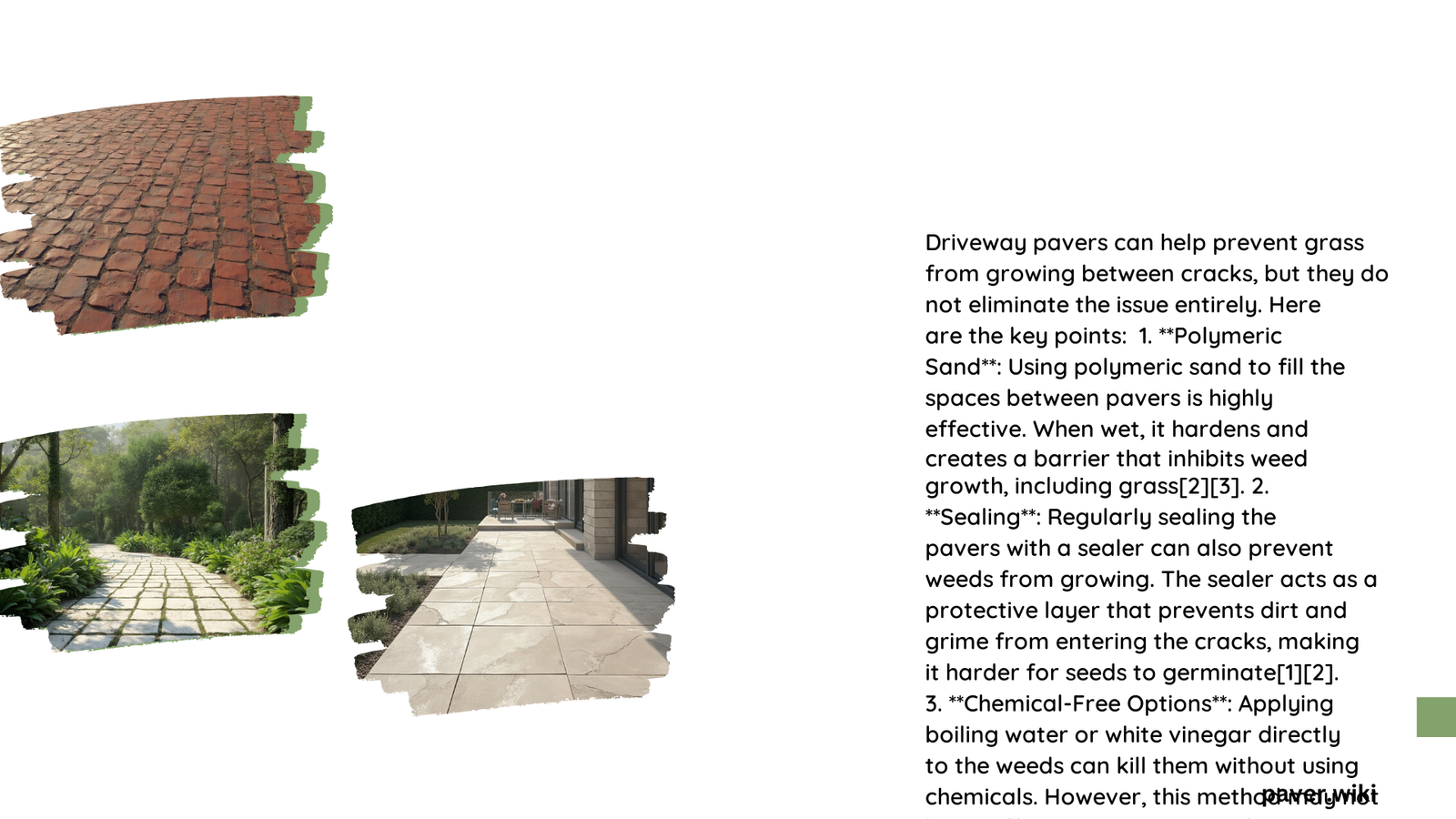Driveway pavers can help control grass growth between cracks, but they don’t completely eliminate the issue. Proper installation, material selection, and regular maintenance are crucial for minimizing grass and weed growth. Interlocking designs, tight spacing, and the use of polymeric sand can significantly reduce the likelihood of grass emerging between pavers. However, ongoing care is necessary to maintain a grass-free driveway.
What Types of Driveway Pavers Are Most Effective Against Grass Growth?
Certain types of driveway pavers are more effective at preventing grass growth between cracks:
- Permeable Concrete Pavers
- Allow water drainage
- Reduce water accumulation
-
Minimize conditions for weed growth
-
Interlocking Pavers
- Tight-fitting design
- Minimize gaps for grass to grow
-
Often used with polymeric sand
-
Grass Block Pavers
- Designed for controlled grass growth
- Require regular maintenance
- Prevent unwanted weed growth
How Does Paver Installation Affect Grass Growth?

Proper installation is crucial for preventing grass growth between pavers:
- Tight Spacing: Minimizes gaps where grass can grow
- Solid Foundation: Prevents settling and shifting that can create spaces
- Proper Drainage: Reduces water accumulation that promotes weed growth
Table: Installation Factors Affecting Grass Growth
| Factor | Impact on Grass Growth |
|---|---|
| Spacing | Tighter spacing reduces growth opportunities |
| Foundation | Solid base prevents shifting and gap formation |
| Drainage | Proper drainage discourages weed growth |
| Sand Filling | Polymeric sand creates a barrier against weeds |
What Maintenance Practices Prevent Grass in Paver Joints?
Regular maintenance is essential to keep grass from growing between pavers:
- Sweeping: Remove debris that can decompose and create soil for weeds
- Pressure Washing: Clean out existing growth and prevent new seeds from settling
- Reapplying Sand: Fill joints with polymeric sand to create a weed barrier
- Herbicide Application: Use targeted treatments for persistent weeds
Can Different Paver Materials Affect Grass Growth?
Yes, paver materials can influence grass growth:
- Concrete Pavers: Dense material resistant to weed penetration
- Natural Stone: May have more irregular shapes, creating potential growth spaces
- Brick Pavers: Smooth surface but may shift over time, creating gaps
What Role Does Joint Width Play in Grass Prevention?
Joint width is critical in preventing grass growth:
- Ideal joint width: 1/8 inch to 1/4 inch
- Narrower joints: Less space for grass to take root
- Wider joints: More prone to weed growth and require more frequent maintenance
How Effective Are Sealants in Preventing Grass Growth?
Sealants can be an additional defense against grass growth:
- Create a barrier on paver surface
- Penetrate joints to prevent weed seed germination
- Require reapplication every 3-5 years for optimal performance
What Are the Long-Term Challenges of Grass Prevention in Pavers?
Long-term grass prevention in pavers faces several challenges:
- Soil Accumulation: Over time, organic matter can collect in joints
- Paver Settling: Can create new spaces for grass to grow
- Sealant Degradation: Effectiveness diminishes over time
- Climate Factors: Rainfall and temperature affect weed growth rates
How Do Environmental Factors Impact Grass Growth in Pavers?
Environmental conditions play a significant role:
- Sunlight: More sun exposure can increase weed growth
- Moisture: Excessive rainfall or poor drainage promotes grass growth
- Temperature: Warmer climates may see more persistent weed issues
What Are the Cost Implications of Grass Prevention in Pavers?
Preventing grass growth in pavers involves ongoing costs:
- Initial installation: $10-$30 per square foot (including materials and labor)
- Annual maintenance: $0.50-$2 per square foot
- Sealant application: $0.50-$1 per square foot every 3-5 years
- Polymeric sand replacement: $1-$3 per square foot as needed
Can Technological Advancements Improve Grass Prevention in Pavers?
Emerging technologies are enhancing grass prevention:
- Advanced Polymeric Sands: Improved binding and weed resistance
- Photocatalytic Coatings: Break down organic matter on paver surfaces
- Smart Irrigation Systems: Reduce excess moisture that promotes weed growth
- Robotic Weed Removers: Automate the process of removing grass between pavers
In conclusion, while driveway pavers can significantly reduce grass growth between cracks, they do not completely eliminate the issue. A combination of proper installation, material selection, and regular maintenance is necessary to keep grass at bay. Homeowners should be prepared for ongoing care to maintain a grass-free driveway paver surface.
References:
1. https://worldofstonesusa.com/blogs/all/grass-pavers-for-driveway
2. https://omconcreteproducts.com/blog/how-to-maintain-grass-block-pavers
3. https://www.truegridpaver.com/5-reasons-to-consider-a-grass-paver-system/
4. https://www.belgard.com/products/pavers/permeable-pavers/
5. https://www.icpi.org/homeowners/maintenance-and-repair
